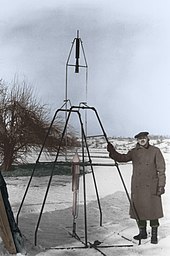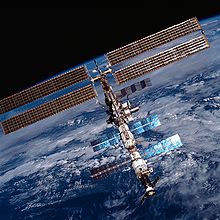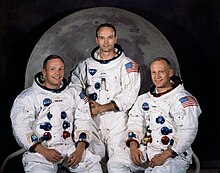History of space travel
The history of space travel includes the planning and implementation of journeys and transports in and through space from the beginning of the 20th century to the present. It includes the social, political and economic framework conditions in which space travel took place and its effect on society.
Thought leader
The Russian Konstantin Ziolkowski (1857–1935) is considered the "father of modern space travel theory". He published in 1903 in the Russian science magazine Scientific Rundschau under the title: "space exploration by reaction apparatuses" for the first time the theoretical effects of a rocket engine as rocket equation the basis of today's space technology . Among other things, he devised the liquid rocket and the multi-stage rocket and also dealt with issues relating to the operation of space stations , the possible industrial use of space and its resources .

The American Robert Goddard (1882–1945) began to think about the construction of rocket motors and space flights to the moon and Mars around 1910 . Because of his visions he was dismissed as a dreamer. In 1926 he was able to successfully test a self-developed liquid rocket for the first time and also achieved some successes with his rockets . Nonetheless, it was almost completely forgotten in relation to space travel. Only posthumously - in the course of the rocket development after the Second World War - was he given appropriate recognition; since then he has been considered the "father of rocket technology ".
In 1923 the Transylvanian Hermann Oberth (1894–1989) published his best-known work The rocket for planetary spaces . With this book, Oberth laid out the theoretical and technical foundations for rockets and space travel; however, the book was not taken seriously in most circles and dismissed as utopian literature. Oberth experimented with building rockets and realized that only liquid fuel developed enough power to reach great heights. From the 1940s he published a work on the optimization of multi-stage rockets . In 1955, Oberth met his former student Wernher von Braun in Huntsville (Alabama) , who had risen to head the American missile program (see also Apollo program ).
Oberth's student Max Valier (1895–1930) took up these ideas in Innsbruck, Vienna and Munich and became a scientific author. With Oberth's support, he published the book Der Vorstoss in den Weltraum in 1924 (six editions until 1930) and described a development program for rocket technology, which was understandable even for laypeople. From the test bench to rocket vehicles and aircraft it led to the space rocket. His experiments followed this path, also with Fritz von Opel (1899–1971), successfully with rocket drives for cars, rail vehicles and airplanes, with various types of propulsion and fuels. Valier died in 1930 while testing liquid fuel when a combustion chamber exploded on the test bench; he is considered the first victim of space travel.
In the late 1920s, there were in Germany by the Society for Space Travel and Fritz Lang's silent film Frau im Mond a boom in the aerospace thought. This led to the establishment of the Berlin rocket airfield in Berlin-Reinickendorf, which was used for the first practical experiments with rocket technology in Germany.
Eugen Sänger (1905–1964) is one of the space pioneers. In 1923, Oberth's book inspired him to undertake special studies in Graz (aircraft construction and construction, Graz University of Technology ). Because of resistance from some professors, he changed his dissertation "Rocket Flight Technology" (1929) in the direction of aircraft construction. Fuel experiments led to the book "Raketenflugtechnik" (1933) - one of the standard works in space literature. At the time of National Socialism in 1936, Sänger moved to the German Aviation Research Institute (DVL) in Berlin-Adlershof (the site later belonged to the Academy of Sciences in the GDR ; the listed test structures like a wind tunnel can still be seen on the corresponding WISTA site today ) and researched the minimum energy expenditure for low-earth orbits . The concept was based on a study of the Sänger space glider , which was developed between 1961 and 1974 and which was ultimately discontinued in 1995 as a Sänger II project for a European space shuttle for economic reasons.
The further development from aircraft to spaceplane should be energetically favorable and also a way out of the arms race . Singer founded the International Astronautical Federation IAF, promoted international space cooperation and was appointed to the new chair “Elements of Space Technology” at the TU Berlin in 1962 , where he died in 1964 during a lecture.
Missiles and rocket planes in World War II
Wernher von Braun became an employee of Oberth from 1929 and from 1937 the technical director of the development program for military missiles in Kummersdorf and later in the Peenemünde Army Research Center (HVA). In 1933 von Braun completed the rocket unit 1 (A1) in Kummersdorf , which was not airworthy due to a faulty design. The successor model, the A2 , got off to a successful start and has already reached a height of several kilometers. The A3 (developed in 1936) was already so big that it was absolutely necessary to move to Peenemünde to the HVA to test it, but the test failed.
In 1942 the first A4 was finally completed. After a failed take-off attempt, the A4 - also known as the "V2" for Vergeltungswaffe 2 - finally lifted off the ground in March 1942. The flight performance of the A4 was continuously increased over the next few months until it finally reached an altitude of 84.5 km in October 1942. She was so ready for use as a weapon and was used as weapons of war first against London used. When tested MW 18014 an altitude of 184 km has been reached and the A4 was thus the first man-made object that the Kármán line , defined boundary of space came in 100 km altitude.
In the course of the Second World War several rocket planes were built , but their military success was rather limited. In the Soviet Union , the Bolchowitinow BI-1 was ready for series production as early as 1942 and the Messerschmitt Me 163 in Germany in 1943 , the developers of which were able to build on their experience with the Lippisch duck . The Bachem Ba 349 , which was still tested in 1945, took off in a vertical direction similar to today's large rockets, but was still an aircraft because the necessary lift in the flight phase was generated by wings.
Soviet and US V-2 missile launches after World War II
While the Soviet Union expanded its own starting program to include around 3,500 German skilled workers and engineers, the United States brought only the top of the HVA Peenemünde to the United States with Wernher von Braun and most of his closest employees. During a period of six weeks after the end of the war, however, the USA transported almost the entire stock of rockets from the Mittelbau-Dora concentration camp , which was located in the zone of occupation assigned to the Soviet Union by the Yalta Conference .
On February 20, 1947, the USA was the first living organism to transport rye and cotton seeds into space with a V2 rocket, along with fruit flies . The suborbital flight was designed to study the effects of high altitude radiation on organisms. The flies came back alive.
In June 1949, a V-2 was the first mammal, the rhesus monkey Albert II , to be transported into space by the US Air Force . On return, the parachute did not open and the rhesus monkey died.
Sputnik and the beginning of manned space travel
Sergei Pavlovich Korolev began building missiles in the Soviet Union in the 1930s. In the course of the Great Terror he was arrested, and only after his release in 1944 was he able to work on rocket developments again. He later became the chief designer of the Soviet missile program. Korolev's name was kept secret from the public for a long time - official announcements only spoke of “the chief designer”.

His first major success was Sputnik 1 , the first artificial earth satellite. It was launched into orbit on October 4, 1957 and was continuously transmitting radio signals. This event received worldwide attention and gave the West the so-called Sputnik shock . The weight of the Sputnik satellite - over 80 kilograms - left no doubt about the launch vehicle's military potential : the USSR now had ICBMs . In the United States, space travel increasingly became a political issue and an election campaign issue. Presidential candidate John F. Kennedy commented on the Sputnik launch with the words: "If the Soviets control space, then they can control the earth, just as in past centuries the nation ruled the continents that also controlled the oceans ."
The Soviet space step progressing swiftly and Sputnik 2 brought in the same year with the dog Laika , the first living creature into orbit. With Sputnik 5 in 1960 even two dogs were launched into orbit and also returned safely to the earth's surface.
The next big step took place on April 12, 1961, when Yuri Gagarin was the first person to orbit the earth in the Vostok 1 . The first American in space, Alan Shepard , carried out a few weeks later on May 5, 1961 as part of the Mercury program, only a 15-minute suborbital flight; so it did not enter orbit around the earth. The first woman in space was the cosmonaut Valentin Tereshkova , who took off on June 16, 1963 on board Vostok 6 for her three-day flight. The first spacewalk , so leaving a space ship, protected only by a spacesuit , finally succeeded Alexey Leonov on March 2, 1965. Leonov was barely escape with their lives.

In 1959, the USSR succeeded in circumnavigating the moon with Lunik 3 , which provided the first photo of the back of the moon, which was not visible from Earth, and in the same year the first hard moon landing with Lunik 2 , during which the satellite was destroyed. In 1966, the first soft moon landing, i.e. the undamaged landing of the missile on the moon's surface, was achieved with Luna 9 .
The Luna 16 and Luna 20 also succeeded in bringing lunar rocks back to Earth, and in 1970 the first unmanned robotic vehicle traveled on the moon ( Lunochod 1 ). In the same year, Venera 7 also made the first soft landing on Venus .
The US catching up and the trip to the moon
On May 25, 1961, US President John F. Kennedy delivered his famous speech in which he promised "before the end of this decade to land a person on the moon and bring him safely back to earth". In 1962 the USA finally succeeded in bringing the first American safely into orbit and back with John Glenn . The Mercury program has now had a successor, the Gemini program . As part of this program, various techniques were tested, all of which would be necessary for the subsequent moon landing. An important step was the Gemini 6 and 7 missions, which were launched in quick succession to test the approach of two spacecraft - a docking maneuver did not take place, however, this was first successfully carried out with Gemini 8.
As a carrier system for the Apollo missions was Saturn rocket developed, which had its maiden flight on 9 November 1967th With the Apollo 7 mission, the complete system was tested for the first time in earth orbit in manned use, and the moon was orbited for the first time with the Apollo 8 mission in 1968.
On the evening of July 20, 1969, the lander of the Apollo 11 spacecraft touched down on the surface of the moon. Neil Armstrong left the lunar module at 3:56 a.m. UT and became the first person to step on the moon. Meanwhile, he coined the legendary saying:
That's one small step for [a] man, one giant leap for mankind. ( )
(That's a small step for a human, but a giant leap for humanity)
On December 7, 1972, Apollo 17 was the last manned trip to the earth's satellite.
Space travel after the last Apollo mission

After the end of the Apollo program, no one left the immediate vicinity of the earth. The focus of manned space travel was the development of reusable transport systems (Space Shuttle, Buran) and space stations in earth orbit. The first space stations were launched in the early 1970s ( Salyut 1 in 1971 and Skylab in 1973 ). In February 1986, the Soviet Union launched the basic module of the Mir space station ( Russian Мир , “peace” or “world”), which was later expanded and, with an operating life of 15 years, far exceeded all previous stations. The International Space Station (ISS) has been permanently manned since November 2000 .
In April 1981, the US space shuttle Columbia launched the first reusable space shuttle . The shuttles were indispensable in the construction of the ISS and enabled a new quality in astronomy with the deployment and the multiple repairs of the Hubble space telescope . Two accidents, each with seven fatalities, tarnish the success of the shuttles: the destruction of the Challenger on January 28, 1986 shortly after take-off and the Columbia on February 1, 2003 upon re-entry. In 2011 the shuttle program was finally ended with the flight of the Atlantis. Since no immediate successor was available, the USA lost the ability to bring astronauts into space in the following years. During this time the Russian Soyuz spaceships took over the transport of people to the ISS.
On October 15, 2003, the People's Republic of China, with the Shenzhou 5 spacecraft, became the third country after the Soviet Union and the USA to bring people into space with its own space system.
On November 12, 2014, the Philae probe, launched by Rosetta, made a soft landing on a comet for the first time .
On December 22, 2015, the American space company SpaceX succeeded for the first time in landing a rocket stage of the Falcon-9 launcher after its mission back on earth. On May 30, 2020, SpaceX succeeded in making the first manned flight to the ISS by a private company with the SpX-DM2 .
See also
literature
- Werner Buedeler: History of space travel. Sigloch Edition, Künzelsau 1999, ISBN 3-89393-194-5 .
- David Darling : The complete book of spaceflight - from Apollo 1 to Zero gravity. Wiley, Hoboken 2003, ISBN 0-471-05649-9 (English).
- Michael Esser: Reaching for the Stars - A History of Space Travel. Birkhäuser, Basel 1999, ISBN 3-7643-5940-4 .
- Michael Krause: A short history of space travel. Cornelsen Scriptor, Berlin 2001, ISBN 3-589-21540-2 .
- Volker Neipp : With screws and bolts to the moon. Springerverlag Trossingen, Trossingen 2008, ISBN 978-3-9802675-7-1 .
- Niklas Reinke: History of the German space policy. Concepts, influencing factors and interdependencies 1923–2002. Oldenbourg, Munich 2004, ISBN 3-486-56842-6 .
- Günter Siefarth : history of space travel. (= Beck series. No. 2153). Beck, Munich 2001, ISBN 3-406-44753-8 .
- Helmuth Trischler , Kai-Uwe Schrogl (Hrsg.): A century in flight - aerospace research in Germany 1907-2007. Campus, Frankfurt am Main / New York 2007, ISBN 978-3-593-38330-9 .
Web links
- Parallel timeline of space history from the beginning to Sputnik + 5 years, in the SU, the USA and Europe (detailed list with all important events in the history of space travel)
- Timeline of robotic exploration of the solar system
- A tabular outline of the history of space travel
- 100 years of aerospace research in Germany (DLR anniversary portal)
Individual evidence
- ↑ Patricia S. Daniels, Linda K. Glover: Rockets and Spacecraft . In: Katharina Harde-Tinnefeld (Ed.): The great National Geographic Encyclopedia Space . G + J / RBA, Hamburg 2005, ISBN 3-937606-25-4 , Konstantin Ziolkowski, p. 182 ( limited preview in Google Book Search [accessed March 30, 2020]).
- ^ Upper Air Rocket Summary. In: Beggs Aerospace featuring the postwar V2. February 20, 1947, accessed January 11, 2019 .
- ↑ a b The animal heroes of space travel. In: The time . May 25, 2011, accessed March 30, 2020 .
- ↑ Due to the pressure difference in comparison to the vacuum in space, the space suit had inflated so much that it no longer fit through the hatch to the spacecraft. He was only able to return when Leonov deflated his suit in an improvised emergency measure. In "Zwei Mann im Mond" (Two Men in the Moon) Leonow describes the panic fight with the 4.5 m long safety line during the space exit.




